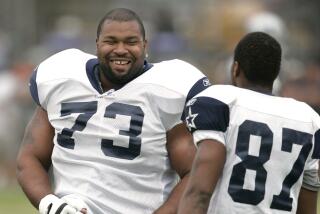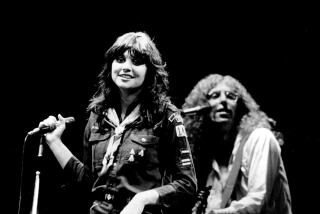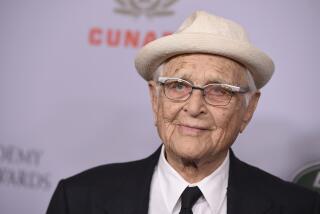Arlen Dies; Composer of âOver the Rainbowâ
Hymen Arluck, a cantorâs son who grew up to become Harold Arlen, the composer who took the world âOver the Rainbow,â died Wednesday at his home in New York City
Arlen, 81, who had suffered from cancer, died at his Manhattan home shortly after 4 p.m., and his body was found in bed by his son, Sam, a police spokesman said.
His death leaves Irving Berlin as the sole survivor of an era of melodic innocence in which boys always got the girls of their choice and generations of Dorothys found their way home from the perplexing Land of Oz.
One of the most prolific tunesmiths of his day, at his death he had spun the melodies for 102 songs, 25 motion pictures, 10 Broadway shows and 3 instrumental suites.
His songs were a lexicon of the United States in all her disparate moods, ranging from âAc-Cen-Tchu-Ate the Positiveâ to âStormy Weatherâ and âBlues in the Night.â
Countless millions hummed his melodic inspirations into the ears of their dance partners in speak-easies, whistled them as they waited in Depression-era bread lines or crooned them over the sounds battleships made as they plied wartime seas.
He was the first of the white composers to write for black audiences and his prodigious output places him second (behind only Berlin) in the number of credits listed in the American Society of Composers, Authors and Publishers Biographical Dictionary.
He gave Pearl Bailey her first big hit with âLegalize My Name,â made a household word of Ethel Waters with âStormy Weather,â and catapulted a young Judy Garland to stardom with the songs from âThe Wizard of Oz,â winning his only Academy Award for âOver the Rainbow.â
It was a career that involved a great deal of skill, but initial luck. It could have been viewed as predictable after that single afternoon in the 1920s when he was working as an accompanist for Vincent Youmans and the orchestra leader heard him âvampingâ at the piano before a rehearsal.
âWhy donât you make a song out of that?â Youmans inquired.
The result was âGet Happy,â a song that became the biggest hit of â9:15 Revue,â a 1930 Broadway musical.
George Gershwin, with his brother, Ira, a neighbor of Arlen when they were boys, called it âThe most exciting finale Iâve ever heard.â
The finale proved the beginning.
Before âGet Happy,â Arlen had labored in the musical vineyards of his day, starting when he was only 7 and singing in the choir of his fatherâs synagogue in his native Buffalo, N.Y. He remembered having to stand on a chair to be seen and heard. He also began taking piano lessons in his seventh year and at 15 was playing professionally in the few Buffalo cafes offering entertainment.
Visits New York
He progressed to playing piano with the âSnappy Trioâ on lake boats, a group he formed with a young violinist and drummer. Shortly, the group doubled in number and became Hymen Arluckâs âYankee Sixâ (later the Southland Shufflers.) In 1924 he made his first journey to New York City and while there heard Miss Waters, for whom he would later write hits.
By 1928 he was believed to have changed his name to Harold Arlen and was working as pianist and arranger for Arnold Johnsonâs Orchestra, the pit band in George Whiteâs annual âScandals.â Youmans lured him away and âGet Happyâ placed him in demand.
In 1930, he crossed the then-tenuous color line and with Ted Koehler collaborated on a series of songs for Harlemâs Cotton Club revues (where Lena Horne was struggling to break out of the chorus.) Cab Calloway sang his âIâve Got the World on a Stringâ and âBetween the Devil and the Deep Blue Sea.â Other songs he wrote for black singers sporadically over the next five years included âI Gotta Right to Sing the Blues,â âMinnie the Moocherâs Wedding Day,â and, for Miss Waters, âStormy Weather.â
In 1933, Arlen made his first foray into films with âItâs Only a Paper Moonâ for Paramountâs âTake a Chanceâ and that initial screen success led to a second, the title song for âLetâs Fall in Love,â for Columbia.
Behind him was a short vaudeville career in which he toured with Lou Holtz and Lyda Roberti and several mostly now forgotten songs that Earl Carroll had commissioned for his âVanities.â
Hits the Rails
He became a frequent sight on the nationâs rail system, leaving Broadway to write movie scores for âStrike Me Pink,â âThe Singing Kid,â âGold Diggers of 1937â and âArtists and Models.â He would stay a few months, complaining that songwriters were usually an afterthought for producers, and then return to New York to compose for âThe Great Magoo,â (which featured Arlenâs evergreen âIf You Believe in Meâ) or âHooray for What,â which starred Ed Wynn.
By the mid 1930s he was collaborating regularly in New York with Ira Gershwin and E.Y. (Yip) Harburg. One 1934 effort featured Ray Bolger warbling âLetâs Take a Walk Around the Blockâ in âLife Begins at 8:40.â
Yarburg eventually would be the lyricist that put words into the mouths of Dorothy, the Scarecrow, the Cowardly Lion and the Tin Man as they trod the yellow brick road to seek favors from Ozâs wizard.
And although âOver the Rainbowâ was voted the Academy of Motion Picture Arts and Sciencesâ favorite song of 1939, it actually was accepted and rejected for the film three times before making the final cut.
Arlen later said the melody came to him after hearing automobile horns in heavy traffic.
âBlues in the Nightâ was an early collaboration with Johnny Mercer and it was written as the title song for the 1941 film starring Priscilla Lane, Lloyd Nolan and Jack Carson as the nucleus of a band of jazz Gypsies. It also featured another Arlen classic, âThis Time the Dreamâs on Me.â
In 1942 he and Mercer teamed again, this time on the film âStar Spangled Rhythm,â a favored wartime musical that featured most of the singing and acting talent on the Paramount lot. Its stars included Bob Hope, Bing Crosby, Fred MacMurray, Susan Hayward, Betty Hutton and even Cecil B. de Mille, the legendary director. Among the Arlen-Mercer contributions was a song that years later launched the career of a singer who wasnât even in the picture--Billy Daniels. The song? âThat Old Black Magic.â
The War Years
Arlen spent much of World War II in Hollywood, writing âOne for My Babyâ and âMy Shining Hourâ in 1943âs âThe Skyâs the Limit,â which featured Fred Astaire.
That year proved a banner one for Arlen. With Mercer he penned âAc-Cen-Tchu-Ate the Positiveâ a duet performed by Bing Crosby and Sonny Tufts in âHere Come the Wavesâ while with Harburg he turned back the clock to the days of his black revues and wrote the score for âCabin in the Sky,â a tour de force for Miss Waters and her teary rendition of âHappiness Is Just a Thing Called Joe.â
The war wound down and Broadway was winding up. Arlen dashed off film scores for âUp in Armsâ and âOut of This World,â then returned to New York for âBloomer Girlâ and its hit song, âTâmorra, Tâmorra.â Next was another black musical, âSt. Louis Womanâ where a young Pearl Bailey captivated audiences with âLegalize My Name.â But he didnât stay long that time, coming back to Hollywood to score âCasbahâ in which Tony Martin declared âFor Every Man Thereâs a Woman.â Martinâs, of course, was Yvonne de Carlo.
In 1954 Warner Bros. decided to remake the 17-year-old âA Star Is Born,â this time with Judy Garland in the title role. Again Arlen gave her superlative songs, âThe Man That Got Awayâ and âBorn in a Trunk.â
When Arlen moved âpermanentlyâ to Hollywood in 1943 he opined that âCalifornia agrees with me. . . .â In 1955, when he and his wife, the former Earl Carroll showgirl Anya Taranda, returned to New York, he said he was âconvinced that New York and the theater are where I belong.â
Last Productive Years
His work in the 1950s and early â60s, the last of his truly productive years, reflected that ambivalence for he continued the cross-country commute, scoring âThe Country Girlâ with Bing Crosby and Grace Kelly and âGay Purr-ee,â an animated feature cartoon about cats in which Miss Garland could be heard along with Robert Goulet and Hermione Gingold. In that same period he wrote songs for âJamaicaâ and âSaratogaâ on Broadway and then adapted many of his earlier triumphs for âThe Harold Arlen Songbookâ which opened in 1967.
He settled permanently in New York after the demise of the film musical but his music continued to be performed on stages across America as recently as 1984 when âGet Happy,â a reprise of 50 of his most enduring melodies, toured the Equity Waiver circuit.
For the last several years his health had confined him to his New York home where he visited occasionally with the precious few Tin Pan Alley survivors who, with Harold Arlen, had crafted forgotten rainbows for the rest of us.
Funeral services will be held Friday with burial at Ferncliff Cemetery in Hartsdale, N.Y.
More to Read
The biggest entertainment stories
Get our big stories about Hollywood, film, television, music, arts, culture and more right in your inbox as soon as they publish.
You may occasionally receive promotional content from the Los Angeles Times.










